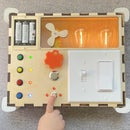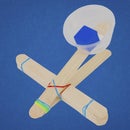Introduction: Create a Maker Space for Kids
A personal maker space is just an area that facilitates creating. In my experience working with kids since 2011, this requires 5 things:
- Enough space
- The right tools
- The right materials
- Organization
- Inspiration
Every kid and every home has different needs and limitations, so please read this as a set of guidelines, not a definitive guide. The young girl living in an urban apartment who wants to create her own line of duct tape accessories will have different needs than the preteen boy who wants to build contraptions in preparation for the zombie apocalypse!
In any case, you can read on to get inspiration for the 5 aspects of your kid's maker space.
Step 1: Choose a Space and Worktable
Find a space that you don't mind getting messy!
I've staked out a spot in the bedroom and placed a small rolling desk that I found at a garage sale for $25. The keyboard tray rolls out which makes a nice active workspace while the desktop will be useful for placing tools and materials that are useful to keep on hand. The cubbies below can store tools and materials.
In this case, I cut a sheet of cardboard and use blue painter's tape to attach it to the working surface to protect it from markers, glue, etc. The painter's tape won't leave a sticky residue, and it will make it easier to change the cardboard later on.
Step 2: Get the Right Tools
The age and interests of your young maker will determine what the right tools are. One who delights in decorative arts and crafts could use glue sticks, rubber cement, or crazy craft scissors. Electronics and light metal work require a soldering iron. This section is really up to you to decide what's best to suit the individual interests of your child.
However there are three things that every young maker should have at their disposal: Scissors, masking tape and hot glue with an insulated nozzle.
Scissors are obvious. Materials don't always come in the right size. Another cutting tool to consider (for adult hands only) is a woodcutting tool, like this one.
Why masking tape? Clear tape is not adhesive or pliable enough; it comes undone too easily. Duct tape, though awesome and should definitely be a consideration, is more difficult for young children to cut, tear, and manipulate (and it's more expensive). Masking tape is great because it's easy to tear and apply, and with some basic techniques, it can attach just about any two crafting materials together.
Hot glue is even more essential. With a hot glue gun, a pile of craft sticks can become a usable doll house within minutes. No waiting overnight for glue to dry, or getting frustrated over weak adhesives. Hot glue is just awesome.
You can buy very cheap glue guns at Micheal's. In my area, the Dollar Tree chain sells really cheap glue guns (20 for $1!) Or buy this one online.
Young children (age 6 or so) can effectively and safely use a hot glue gun with careful introduction, guided practice, and having the right mindset. Rather than focusing on the dangers of hot glue, focus on it's benefits. Try introducing hot glue as follows:
- Hot glue is great because it is easy to use and it dries very quickly.
- This means that you can build something, test it out, add onto it, play with it, and build some more all in one making session.
- However, hot glue is hot! The glue gun needs to get hot enough to melt the solid glue. The tip of the glue gun is the hottest part, and the glue when it first comes out is also very hot. Keep your fingers away from these.
- Demonstrate how to hold a glue gun and how to assemble things without getting your fingers too close.
- As a rule of thumb, always try to put hot glue on the bigger of two objects. Putting hot glue on a small object that's being held with your fingertips is risky.
- If you do get burned, run your hand under cold water and count to 50. Repeat if necessary.
- Burns that persist can be treated by applying and removing an ice pack as needed.
In my experience as an educator for elementary school-aged children, the vast majority of them love using a hot glue gun, and the benefits far outweigh the risks. Additionally, allowing young children to use a glue gun builds self confidence as a person and as a maker. Not many kids get to independently use a glue gun!
Step 3: Gather Materials
Your material choice will depend on many factors: child's age, budget, space, and availability. This example is for children of elementary school age, and with a modest budget and space efficiency in mind.
First, talk to your child about the things they think they need to make what they want! If they're not sure, find a variety of craft supplies and see what interests them. It's important to find a variety of interesting supplies, because limited supplies can limit the imagination. Great places to find inspiring materials include:
- Reuse stores. These are stores that accept material donations and resell them at a low cost. Search Google Maps or Yelp in your area for "reuse store." The content of these stores can range from discounted crafting goods to wholesale hardware.
- Thrift stores. Cheap appliances and toys can be disassembled for a bevy of interesting parts.
- Local recycling center. Call ahead of time and ask if they'll allow you to take cardboard boxes, plastic bottles, and more.
Step 4: Get Organized
There is something delightful about rummaging through a bin of random materials, however it can be discouraging when you need to find 50 craft sticks at the bottom.
Shop around for something to keep your materials organized. Keep in mind that your young maker might not keep things as organized as you, so it may be prudent to use 3-10 containers that keep things organized by a general material type versus individual materials. (Ex: A container for all recyclables instead of a container for toilet paper tubes, another container for cereal boxes, and a third for cardboard boxes)
For my maker space, I selected a set of craft storage drawers since I intend to store woodcraft and small plastic components. The clear plastic also makes it easy to select the right material without labels. It cost less than $30 on Amazon.
Step 5: Provide Inspiration
You're ready to make! But wait - how exactly do you begin that huge marble roller coaster that you saw on Youtube once, like, a month ago?
Once you have a great idea, the next step is to search the web to find out if anyone else has tried something similar, and if so, what great ideas are out there for you to build on. Yes, it's very gratifying to come up with a totally unique project idea, and it's just as gratifying to take existing ideas and combine them in new ways. Creating projects that are inspired by others also helps build skills and experiences that your young maker can draw upon later.
Here are some resources to start with:
http://makerfaire.com/bay-area-2014/maker-info/ (particularly the kids section)
https://www.instructables.com/id/Project-Based-Engi... (The collection of Young Engineers projects)
http://thecardboardcollective.com/project-gallery-...
Here are some tips for finding inspiration to match your young maker's vision:
- Search Google images vs. Google web search - it's much faster to find what you're looking for. Try changing one word at a time in your search until you find a rich phrase (Ex: marble roller coaster vs. ball roller coaster vs. ball Rube Goldberg). If you find an image that you like, follow it to it's source.
- Search Pinterest using words like "kids" "art" "craft" "engineering" "stem" "make" "fun." There are a lot of dedicated parents who've collected pages and pages of inspiring images and project ideas.











